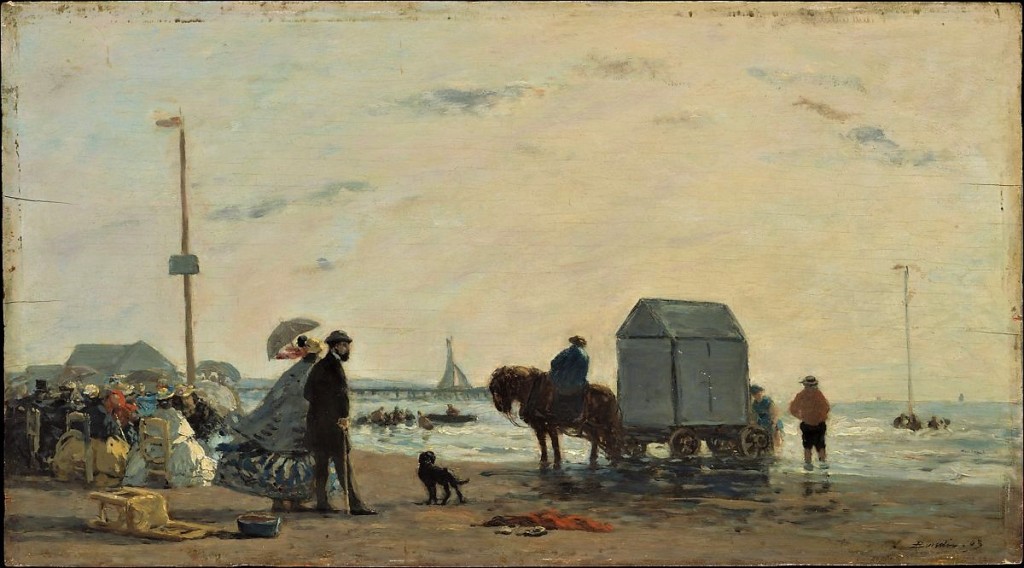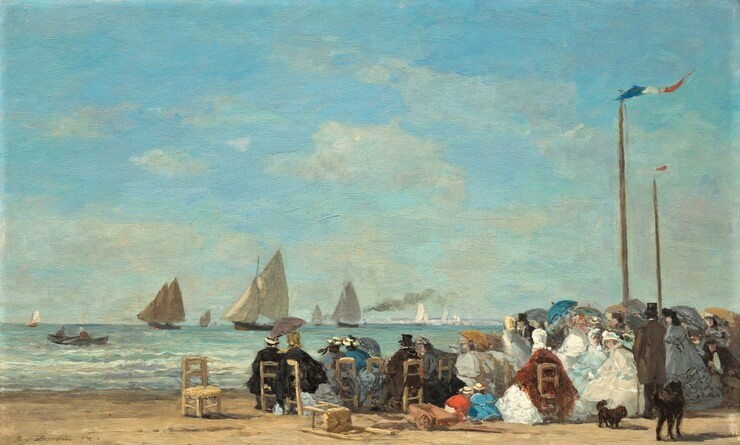
Grove Koger
A factor I value more and more in art as I see more and more paintings is weather: wind and clouds and sky, along with evidence of the season and suggestions of the temperature and the time of day. Entire eras seem to have passed in which artists took no notice of the weather, concentrating (it seems) on less ephemeral aspects of life. And yet most of those were eras in which heating and cooling systems were primitive, so the weather on any particular day must have been a concern. Today, of course, is a different story, and whatever the strengths and weaknesses of any particular artist or work, weather doesn’t seem to play much of a part. And I miss it.
Surely one of the factors involved in these developments has to do with where artists actually paint. A studio is one thing, but the open air is another, and Eugène Boudin, who died August 8, 1898, was one of the first French artists to work en plein air, as the French put it, or outdoors.

We seem to have Henri de Valenciennes (1750-1819) to thank for the concept. He himself painted outdoors, and expounded his theories in his 1800 book Elémens de perspective pratique, a l’usage des artistes suivis de réflexions et conseils à un elève sur la peinture, et particulièrement sur le genre du paysage. There had been numerous reasons for working in the studio, ranging from the cumbersome process of preparing and mixing pigments to the difficulty of moving easels and canvases—not to mention the conservative attitudes common to academic art teachers. But the introduction of the box easel and paint in tubes made all the difference.
Boudin came by his vocation and his favorite subjects—the seaboard and the sky—naturally. He was born in 1824 in Honfleur, a port near the mouth of the Seine on the English Channel where his father worked as a harbor pilot. In 1835, the elder Boudin moved his family across the river to the larger port of Le Havre, where he opened a stationary and framing shop. There the young Boudin, who had himself worked for a time on a steamboat, met artists such as Jean-François Millet, who displayed his work in the shop and who encouraged Boudin’s interest in painting. Subsequently Boudin studied in Paris, where he saw and admired the works of Jean-Baptiste-Camille Corot, who would later call him the “master of the sky.”

Boudin painted his subjects directly and with care, even noting the atmospheric conditions and the time of day on the backs of his canvases. Some of his paintings are of unaffectedly natural scenes: cattle grazing peacefully, for instance, and sailing ships careened at low tide. But he owes his most characteristic works to an important technological achievement—the construction of the 142-mile Ligne Paris-Le Havre, which was completed in 1847. The railway made it possible for middle-class and aristocratic Parisians to visit the seaside. And visit they did, encouraged by the example of President (later Emperor) Napoleon III and his wife, the Empress Eugénie, both of whom popularized bathing in the sea.
Thus it’s scenes of smart Parisian tourists, stylishly (over)dressed and grouped within sight of the water, some standing, most comfortably seated, that Boudin painted by the dozens. There’s often a dog, and occasionally we see “bathing machines”—wheeled carts in which the bravest souls could change into somewhat less cumbersome costumes and be helped into the water.

Boudin’s natural affinity with the early impressionists led to his exhibiting with them in 1874, although he subsequently gravitated to the more conservative Paris Salons. “I am a loner,” he once remarked, “a daydreamer who has been content to remain in his part of the world and look at the sky.” The loner began to enjoy official attention in the late 1880s, and was awarded the Legion of Honour in 1892.
□□□
The image at the top of today’s post is Boudin’s painting The Beach near Trouville, c. 1865. The portrait is by Pierre Petit, and is reproduced courtesy of the Archives Larousse, Paris. The second painting is On the Beach near Trouville, and was painted about 1863. The final image is Beach Scene at Trouville, another painting dating from 1863.